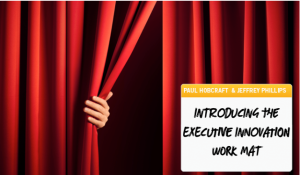I’m right in the middle of a launch of the Executive Innovation Work Mat approach, a series of seven blogs outlining a framework and structured approach to this.
During the seven days these will document seven important “domains” that determine innovation success or failure.
Each domain creates innovation potential, but sustained, successful innovation requires a unified “framework” in which all of these domains are appropriately engaged and aligned.
The development of this framework, which we call the Executive Innovation Work Mat, is the responsibility of the CEO or senior executive. They can deliver alignment by engaging and providing this leadership required in innovation.

If you have the opportunity, do go over to the www.innovationexcellence.com site to see the first two blogs, the foundation document and whose role it is to design this and why.
The first document is called The Seven Essential Domains for Innovation Leadership – the Work Mat Approach and the second The Critical Role that Senior Leaders must fill for Innovation Success
As this is a collaborative effort between Jeffrey Phillips and me, we see this opening series as the engagement to the innovation community. We are looking for feedback and thoughts to take this forward as we clearly believe it is an important problem within innovation to break down. Continue reading “Seeking engagement for innovation change”

